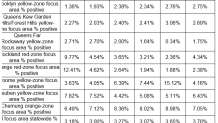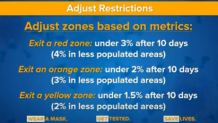What to Know
- New York state on Wednesday topped 500,000 confirmed COVID cases, the fourth-highest total in America; it still has reported far more deaths than any other U.S. state and many other countries
- Gov. Andrew Cuomo has touted his micro-cluster strategy as an effective containment tool; it appears to be working in the city, and Orange County is poised to see restrictions ease next week
- Despite its cluster battles, NY still has the second-lowest virus rate in the nation, Cuomo says -- even as NBC numbers show U.S. COVID-19 infections are spreading at the fastest rate since the pandemic's start
Nearly eight months to the day it announced its first coronavirus case in New York City, the Empire State has topped a half-million confirmed COVID cases, the fourth-highest total in the nation behind Texas, California and Florida.
Gov. Andrew Cuomo added 2,031 new cases to the tally Wednesday, the highest single-day number in months, bringing New York's total number of confirmed coronavirus cases to 500,677. Officials acknowledge the actual number of cases could be 10 times higher -- or more -- given testing and societal constraints. New York tests more per capita than any place in the world, Cuomo has said. Still, asymptomatic and other cases inevitably slip through the cracks to some degree.
Back in April, that 500,000-case milestone seemed like a rapidly approaching inevitable for New York. Then, over the summer as infection rates plunged to lows few other states have seen since, it appeared the former epicenter of the national crisis had cracked the code to containment. Now, as cases rise in virtually every U.S. state (and deaths in most of them), the numbers are creeping up in New York.
Despite its recent upticks, the Empire State has the nation's second-lowest infection rate, according to Wednesday data from Johns Hopkins. Cuomo says New York has "defied the rate of increase" overwhelming the rest of the country thus far, adding, "Knock on wood," for good measure.
Get Tri-state area news delivered to your inbox. Sign up for NBC New York's News Headlines newsletter.
Various cluster areas in Brooklyn, Queens, Rockland and Orange counties have driven the vast majority of New York's new cases and its new hospitalizations, the latter of which is now in the midst of a six-day stretch above 1,000. The daily death toll has been inching up too (it hit a recent high of 15 the last two days), but it still falls remarkably, and mercifully, well before the 800-a-day losses in April.
New York City reported a recent high of 105 new hospital admissions Wednesday, while the daily COVID case average topped Mayor Bill de Blasio's 550-threshold (552) for the third time in about a week. Those numbers are at months-long highs.
Gov. Cuomo has touted his micro-cluster strategy as an effective control tool; it appears to be working in the city and overall, though he says some areas need to see more improvement before they can loosen restrictions.
De Blasio said he was "hopeful" that new restrictions imposed on problem areas of Brooklyn could be lifted in the next week or so, but noted that decision is entirely up to the governor. He previously said the red, orange and yellow zone maps would be reassessed every 10 days and restrictions adjusted accordingly. (Here's a quick look at all the updated cluster zone maps and a reminder of the rules.)
Later Wednesday, Cuomo said no Brooklyn red zones would be changed next week or any other red zone maps but Orange County, which will be moved orange if the numbers hold. Red zone areas in that county have a 1.94 percent rolling seven-day rate as of Wednesday, down from 12.4 percent three weeks ago.
"In terms of adjustments of the micro-clusters, Orange County has made very good progress," the governor said, noting that the hospitalization rate there has also flattened.

Brooklyn's red zone areas have a 3.57 percent positivity rate over a rolling seven-day period, which falls short of the progress Cuomo wants to see before he makes a change. The city's other cluster zone areas are in Queens and those are all yellow zones, meaning they have heightened precautions in schools -- like mandatory weekly testing -- but can keep those and businesses open.
Far Rockaway has seen the most rapid progress; that yellow zone now has a rolling weekly positivity rate of 1.64 percent. It'll have to get even lower to move out of a cluster zone area entirely, based on the benchmarks Cuomo revealed last week.

Combined, all red, orange and yellow zones in New York have a rolling positivity rate of 3.07 percent, which is still 10 to 15 times lower than some of America's most struggling states are seeing right now. As of Wednesday, the daily positivity rate in those areas was 3.8 percent. New York's daily infection rate was 1.56 percent including those focus areas, which are oversampled in testing, and 1.37 percent without them. Over a seven-day rolling period, it's 1.17 percent.
New York City's seven-day rolling average, by de Blasio's report, is 1.75 percent as of Wednesday, ticking up perilously close to the 2 percent-threshold he set for shuttering indoor dining across all five boroughs. But both de Blasio and Cuomo continue to urge people not to be too concerned about small upticks or clusters.
Daily Percentage of Positive Tests by New York Region
Gov. Andrew Cuomo breaks the state into 10 regions for testing purposes and tracks positivity rates to identify potential hotspots. Here's the latest tracking data by region and for the five boroughs. For the latest county-level results statewide, click here
Source: ny.gov
Cuomo has warned micro-clusters will be the new normal heading through fall and he plans to implement the same hyperlocal strategy regarding restrictions to curb the risk of spread. By the time winter comes, he hopes to have a safe, widely available and effective vaccine, but has expressed doubt one could be deliverable to up to 40 million New Yorkers by December. Dr. Anthony Fauci, the nation's leading infectious disease expert, has warned mitigation measures like masks and social distancing will be needed well after the initial rollout of any vaccine — and that a return to normal is still a long ways off.
"If normal means you can get people into the theater without worrying about what we call congregate settings, superspreaders, if you could get restaurants to open at full capacity, sporting events with spectators, then I think that is going to be well into 2021 and perhaps beyond," Fauci said while talking with students and staff at the University of Melbourne in Australia, where things are starting to reopen after shutdown of their own for four months.
Fauci has also expressed grave concern that the United States is trending in a dangerous direction as colder weather and the holiday season approach. COVID-19 infections are spreading across the United States at the fastest rate since the start of the pandemic, the latest NBC News figures showed Tuesday.
Tracking Coronavirus in Tri-State
The 71,000 new cases per day that the U.S. averaged over the past week was the most in any seven-day stretch since the crisis started, standing in stark contrast to President Donald Trump’s claims “we are rounding the turn” on the pandemic. Deaths per day have soared 10 percent nationwide in the last two weeks.
And no part of the country has gone untouched by this latest surge. In New Jersey, another city is implementing a curfew due to a recent spike in COVID cases. The number of new cases has nearly tripled over the past three days in Paterson, prompting the mayor to issue an executive order clamping down on dining and nightlife starting at midnight Thursday.
The city has dealt with an uptick in noncompliance lately, with the city providing recent photos and videos showing crowds of people partying and gathered inside bars, nightclubs and hookah lounges without face masks or social distancing. Food delivery and pickups will still be allowed after midnight, however, and the Paterson Public Safety Office added that a task force would be actively enforcing the shutdowns and issuing tickets to those who don't comply with the new mandate.
To date, the United States has confirmed more than 8.7 million cases, more than any country in the world by nearly a million, and reported nearly 227,000 deaths, about 69,000 more than the next closest country (Brazil), according to the latest data from Johns Hopkins.



